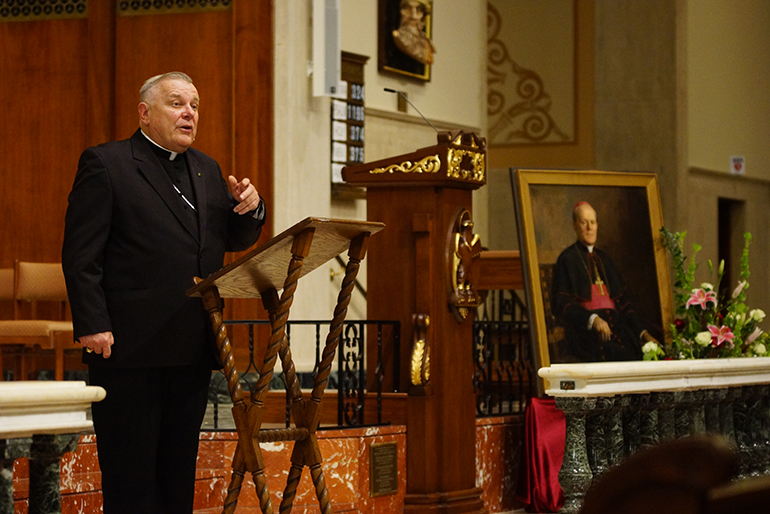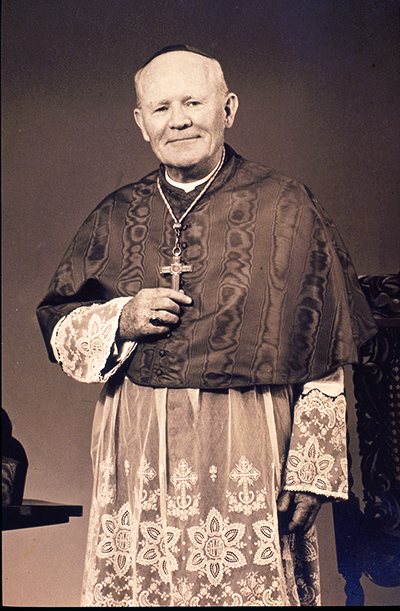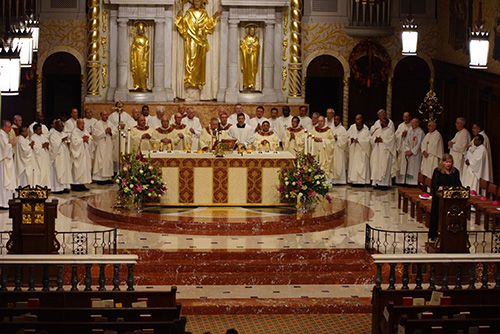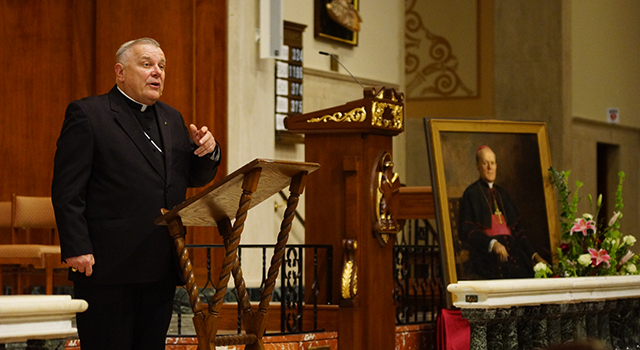By Archbishop Thomas Wenski - The Archdiocese of Miami

Photographer: COURTESY | Sr. Elizabeth Worley
Archbishop Thomas Wenski speaks about Archbishop Joseph P. Hurley of St. Augustine during a talk at the cathedral basilica there Oct. 31, the 50th anniversary of his death. The archbishop later presided at a Mass with all the bishops of Florida, where Bishop John Noonan of Orlando preached the homily.
Archbishop Thomas Wenski delivered this talk Oct. 30, 2017, in St. Augustine, Fla., at the commemoration of the 50th anniversary of the death of Archbishop Joseph P. Hurley, sixth bishop of the Diocese of St. Augustine, which at one time encompassed all of Florida. (See video of the talk below.)
Joseph Hurley (1894-1967) became the bishop of St. Augustine in 1940. He was named shortly after the death of Bishop Patrick Barry. The St. Augustine Diocese encompassed the whole state of Florida, except for the western part of the Panhandle which was joined to the Diocese of Mobile in Alabama. It had been and was, at the time of Hurley’s arrival, “mission territory.” Catholics were few in number and scattered throughout the state. Given the size of the state and a chronic shortage of priests, along with a precarious financial situation due to the laisse faire administration of his predecessor and America’s proximate entry into World War II, he faced considerable challenges. But he was a man imbued with great self-confidence, a sense of destiny and vibrancy. He had both a prophetic vision and pragmatic organizational skills. He was up to the tasks ahead of him.
How did he get to St. Augustine? One could have surmised given his talents and his “connections” within the Church, both in the US and in Rome, that he would have been destined for a larger, more prominent See than the ecclesiastical “backwater” that was the Diocese of St. Augustine. Providence, however, brought him here.
Born in Ohio, he was ordained a priest of the Diocese of Cleveland in 1919. That he was ordained a priest also shows the hand of Providence. Before opting to enter the seminary, he had been nominated to the Military Academy at West Point. The nomination, however, was withdrawn � on perhaps what could be considered a technicality. He did not belong to the district of the congressman who nominated him. Had he gone to West Point, he would have been a classmate of Dwight David Eisenhower. But, again, Divine Providence had plans for a different type of service.

Archbishop Joseph P. Hurley, bishop of St. Augustine, Fla., from 1940 until his death Oct. 30, 1967, at the age of 73.
While a priest, he caught the eye of a bishop working in the Holy See’s diplomatic service. This bishop, the future Cardinal Edward Mooney, brought him with him to India where Mooney had been posted as Apostolic Delegate. Later, when Mooney was assigned to Japan, Hurley accompanied him. In fact, in the mid-30s, as Japan went to war in the Far East invading Manchuria and China, it was Hurley, in the absence of Mooney, who had to close down the Nunciature in 1934. He returned to Rome where he worked in the Vatican’s Secretariat of State. He enjoyed the confidence of the then Pius XI. Pius XI liked him, Pius XII not so much.
So you could say that he “was promoted” to “remove” him � something not unknown in Vatican circles then or now. So that explains his posting to St. Augustine.
But coming back to the US as bishop when he did also proved providential. FDR recruited him to help win Catholic support for the war that FDR knew was coming. Prior to WWII, the American population was isolationist and FDR understood that Catholics shared in that sentiment; and that Catholics � at least, those of Irish descent � would not favor entering the war on the side of the British. Hurley, in Op-Ed columns in his diocesan and secular papers, warned of the dangers of National Socialism. When war came, Hurley was not shy in asking for a quid pro quo from FDR. He lobbied for and won the posting of a Coast Guard station in St. Augustine that brought an infusion of jobs and money to an area still struggling with the aftermath of the Great Recession.
St. Augustine Diocese � again basically the whole state of Florida � had in 1940 about 99 priests for about 73 parishes. One of the first things he did � unusual for the times � was to commission a sociological study of the entire diocese � a study that was undertaken by CUA, which surveyed the diocese from 1941-44. And, already at that time, he recognized the importance of South Florida, where even then a significant number of the Catholics of his diocese lived. When he began the Annual Catholic Charities Drive it was headquartered in Miami. And he assigned quotas to each parish that the pastors had to meet � and if they didn’t they would have to borrow the money to pay him.
He used to say there were two types of bishops � bishops who sat behind their desks and bishops who rode the fences. And as befitting the missionary nature of Florida, he rode the fences. He worked hard and expected his priests to do the same. While demanding of his priests, he knew them all by name and if they were sick he would visit them and if they were in trouble (alcoholism affected a goodly number of them) he would help them out with great kindness but firmness. But he did not tolerate dissent. When the Barrys gave him some opposition (these were siblings of the previous bishop � one an influential pastor in Miami Beach, the other a nun who founded and ran Barry College, named for their brother), he reminded them that he “was in charge,” telling them in so many words that they would be better off having him as a friend than an enemy. In riding the fences, as it were, he set up “co-chanceries” around the state: in St. Petersburg, in Palm Beach, in Orlando and in Miami. He would travel by car � a priest secretary as his driver � and him in the back seat which he had converted into his office. If not traveling by car, he rode the train. This ministry of presence allowed him to centralize the administration of the diocese around the office of the bishop.
In 1940, Florida was the 27th most populous state; by 1960, it was the 10th most populous state. Between 1940 and 1960, the state grew 161 percent. (Today, Florida is #3 � edging past New York in the last census). Air conditioning, DDT (to deal with the bugs) and home financing loans to returning veterans helped fuel the growth of the state.
Already, even during the war years, Hurley undertook a forward-looking strategy of buying property � methodically and in quantity. (More on that later.) He also sought to grow the number of clergy. Florida-born and bred vocations were in short supply � and so he went recruiting. Mostly to Ireland, but also to Spain (as early as 1940, he told his priests to learn Spanish � but few took him up on it.) He also sought to recruit from the North. During the war years, with military training bases established throughout Florida, the Catholic population grew considerably and he begged northern bishops to send help. He got about 50 to come temporarily to minister to the GIs; but complained bitterly about the indifference of many of his brother bishops to his pleas. (And in addition to GIs, Catholic priests ministered to British soldiers training in Florida, many of whom were Catholic, as well as to German POWs, many of whom were also Catholic.)
At the end of the war, in December of 1945, Pope Pius XII, who had exiled him to Florida, called him back into the Vatican’s diplomatic service � while he remained Bishop of St. Augustine. For almost five years, he was absent from the diocese, assigned to the delicate post of nuncio in Yugoslavia, where he attended the kangaroo trial of Cardinal Stepinac, leader of the Croatian Catholics. (There’s a famous photo of him in the courtroom. He attended the trial � and he would be the only one who would stand when Stepinac was brought into the court.) Stepinac would later die in prison, poisoned by his communist captors. He is now beatified � and his canonization is on hold because the Orthodox Serbians oppose it.
But even though he was away from the diocese, he governed through his former chancellor, who was ordained an auxiliary bishop in his 30s, Thomas McDonough. (He would later go on to be the Archbishop of Louisville, Kentucky.) McDonough was tasked with implementing Hurley’s vision � which included building hospitals like Mercy Hospital in Miami � and finding the money to do so (often in spite of the complaints of the local pastors who had to ask the people again for their funds.) During summers, he would rent a villa in Italy where his seminarians studying in Rome would live with him.
When he came back from Yugoslavia, he had a broader experience of the Church and the world. He also now had the title of Archbishop. Nuncios or apostolic delegates are named “Archbishop” ad personam. It’s a title that attaches to themselves and not to a particular territory. So, Archbishop Hurley was the Bishop of St. Augustine, a diocese and not an archdiocese or Metropolitan See. (Florida � or the Diocese of St. Augustine which encompassed most of Florida � was part of the ecclesiastical province of Baltimore where one former priest and bishop of St. Augustine, Michael Joseph Curley, was sent as its archbishop. In a bit of ecclesiastical trivia, he also became, while remaining Archbishop of Baltimore, the first Archbishop of Washington, DC.)

Photographer: COURTESY | Sr. Elizabeth Worley
Archbishop Thomas Wenski presides at a Mass with all the bishops of Florida in memory of the 50th anniversary of the death of Archbishop Joseph P. Hurley of St. Augustine. Bishop John Noonan of Orlando preached the homily. Prior to the Mass, the archbishop spoke about Archbishop Hurley. The event took place at the cathedral basilica of St. Augustine Oct. 31.
His vision for the future of Florida required some great pragmatic organization skills and strategy. He undertook another major fund drive: a burse appeal to provide for the education of future priests. The goal was an unheard of $5,000,000 � in addition to the annual appeal. And again, pastors were told to meet the goal, or borrow the money to do so.
But rather than investing the burse in the stock market, he invested in real estate. He would send priests to school board offices to find out where they were planning to build schools; he’d send them also to the phone company and FPL to be informed about future trends. And with savvy, he bought up land throughout the state � when land was still cheap.
He got the nickname “10-acre Hurley” because he would acquire 10-acre lots for future parish development � looking for locations along a main road, and spacing out the purchases every three or four miles. In South Florida, you can go down US I, or US 27 or US 441, and find parishes today that are thriving because of his foresight.
Of course, he also bought up larger tracks: 25 acres in some places, 130 acres or more in other places. These larger tracks were for institutional development � and Hurley dreamt big. He foresaw future high schools, universities and seminaries that would arise on the land that he bought.
Hurley, we could say, innovated a new way of parish development. In the north, parishes often grew from the bottom up rather than the top down, procedures that Hurley introduced. In the north, often an ethnic group would come together, maybe even purchase land and then go to the bishop looking for approval � and they often had already recruited their own priests. Florida was a different reality � Florida Catholics � because they often came from someplace else and, in the process of moving, grew somewhat lukewarm in their faith. That sociological survey from the 1940s found that 50 percent of the Catholics in Florida were in mixed marriages and that there were many more lapsed Catholics than practicing Catholics. Such statistics are not surprising today � but in the ‘40s it was an eye-opener.
So a parish was more often than not started in the following way. The property had already been secured � and when the time was right (following growth trends, etc.) a priest was named pastor of a newly established parish. He might have been given some money to go out and find a place to rent as a temporary rectory. But the rest was up to him � and his new parishioners. He had to find a place to say Mass � public schools, funeral parlors, fire stations, store fronts were often the first places that the parishioners gathered. Then he had to convince the Catholics to go there and to raise the money to build a church and a school (the school often coming first). The first churches were inevitably practical, utilitarian A-frame buildings. Parishioners had to raise 25 percent in cash before construction could begin � and once the temporary church was built, the parish would start being billed for the land � at cost plus 6 percent interest.
But the formula by and large worked. Parishes were in many ways more dynamic than many of those up north: few entrenched traditions make for some innovation. A lot of lapsed Catholics got re-engaged in the Church through participation in building their new parishes. Give people something to do for the Church � and even if they weren’t totally with the program they often grow into it.
And having centralized power around the person of Bishop, he had the power and control to allocate the scarce resources to meet present and future needs. Hurley’s tenure as bishop of St. Augustine was the period of the most rapid growth in the history of Florida Catholicism. And much of the growth that has happened since was made possible by the land bank acquired by the Church � again when the land was cheap.
Without having that land, the growth of the Church here in Florida would have been hobbled from the start. As I said, the growth was extraordinary � 160 percent in the 20 years between 1940 and 1960. In fact, in South Florida there are some Catholics that have been in 13 parishes � without ever having moved from their domicile. Imagine that � 13 capital campaigns to build a new church. And, in some places, those A frame buildings have been replaced by permanent churches. I know of one parish, St. Peter and Paul in Orlando diocese, that is now in its third church building.
Of course, all this growth suggested that the Catholic Church in Florida was becoming too big to be administered by one bishop in one diocese. The eventuality of a new diocese being created in Florida was not unexpected or unanticipated by Archbishop Hurley. Indeed, in anticipating a new diocese, Hurley had already begun to shift some priests around � because priests would belong to one or the other diocese depending where they were assigned.
Hurley had suggested � and he had expected that his suggestion be followed � that Florida be divided into two dioceses along longitudinal and not latitudinal lines: in other words, a split between east and west Florida � with the new diocese located in St. Petersburg. St. Petersburg diocese would come, as would Orlando, but in 1968, after Hurley’s death. Hurley’s proposition had some merit: Transportation along the east coast was easier � with US I and the train. But as you already know, that’s not what happened. In late 1958, everything from Vero Beach and below became the Diocese of Miami; St. Augustine retained Tampa-St. Pete, Orlando (before Disney) and everything north.
Hurley was not just a little disappointed. He had bet on his proposition prevailing � especially as he purchased land heavily in South Florida using the resources of the entire diocese. Also, at the time of the split, he was in the process of establishing a series of regional Catholic high schools to replace parish high schools that were no longer economically and academically viable. And of course, to do that he was raising money throughout his diocese � and losing the money from South Florida could jeopardize those high schools being built in the northern part of the diocese. But to add insult to injury, he was not offered the opportunity to become the first Bishop of Miami � which because of the demographics became the larger entity � with more Catholics and more wealth than the remaining part of the Diocese of St. Augustine. He was said to have exclaimed, “We are reduced to poverty in all but history.”
The new bishop was Coleman Carroll, the former auxiliary Bishop of Pittsburg. Coleman Carroll was not unknown to Hurley. When he was still a priest, Hurley had invited him to preach a retreat to high school students at the then St. Mary’s High School in Miami. Coleman Carroll’s brother, Walter, was a Monsignor working in the Vatican Secretariat of State. In fact, he took Hurley’s job when he became the bishop of St. Augustine. Walter with his mother had vacationed with Hurley in Palm Beach.
The Church is a divine institution but she is also a human institution � and so the transition was marked by some bitter disputes � which unfortunately created some bad blood between the two churchmen that endured until Hurley’s death in 1967. (Perhaps there is some irony in Bishop Estevez’s invitation to me � as a successor to Coleman Carroll � to speak here today.)
The controversies centered on three areas � and concerned what would be a fair and equitable distributions of the assets between the two dioceses. Hurley had begun to shuffle priests around before the split and he stopped when it occurred, which left him with about 20 priests that otherwise would have ended up in the Miami diocese. But then which diocese gets the seminarians? That was more complicated than it seemed because there were a number of “international” seminarians � mostly Irish. It was resolved with the help of Rome. The Florida seminarians would belong to the diocese of their parents’ domicile. As for the Irish, Pope John XXIII went down an alphabetical list of the seminarians, assigning one to St. Augustine and the other to Miami and so on. The other disputes � as in most disputes � had to do with money, and real estate. Hurley had bought some 328 parcels of land and 159 parcels were now in the Diocese of Miami. He wanted to be reimbursed � and would turn over title. Again, Rome would have to decide � and each side had both their civil and canonical lawyers. In the end, Pope Paul VI brought the controversy to an end � during the Second Vatican Council � when both prelates were in Rome. As in most legal settlements, both sides did not get as much as they claimed but each got more than they expected.
That the controversy lasted to well in the ‘60s was unfortunate. And it created no little difficulty for the new Diocese of Miami � because the growth of the Church in South Florida was not going to wait until the controversy was resolved. Indeed, a few months after the creation of the Diocese of Miami, the Cuban revolution would spur new growth and new challenges for South Florida. Since the dispute tied up land titles, the plans to build Biscayne College (now St. Thomas University) were held hostage and the new Diocese of Miami had difficulty in getting credit. Banks wouldn’t loan to it. Fortunately, besides being a good fundraiser, Coleman Carroll easily mixed with the people of influence and affluence. He was able to secure a $1,000,000 loan from an unlikely source, Jimmy Hoffa. Many eyebrows were raised � but he said the money wasn’t from the Teamsters’ Union but from their pension funds � and those monies were contributed by those who hired teamsters. And, it was going to be used to build a nursing home for the elderly in Miami � which it was. But that loan opened the doors for the Diocese of Miami to get further loans from the banks.
In the controversy, both men remained Churchmen � their relationship may have been “frosty” but they were always correct. And most people in the pew were unaware of the goings-on. In many ways, Coleman Carroll was a worthy successor of Hurley � he too was a visionary and hard worker � and a builder. Coleman Carroll built on what Joseph Hurley had envisioned. The legacies of each one are intertwined.
Shorted after Hurley died, the Dioceses of Orlando and St. Petersburg were established in 1968. Miami was elevated to the status of Archdiocese and Coleman Carroll became the first Metropolitan Archbishop of Miami, which now included Orlando, St. Petersburg and St. Augustine as suffragan sees. In the late 1970s came the Diocese of Pensacola-Tallahassee; in 1983, Palm Beach and Venice. The foresight and vision of Hurley enabled these dioceses and their bishops to respond to the challenges of growth in the evangelization of Florida. Thanks to Archbishop Hurley, the land was there, diocesan organizations and structures, the priests were there � and the rest, as they say, is history.
(I am grateful to Fr. Michael McNally � his book, “Catholicism in South Florida 1868-1968,” helped me immensely in preparing this talk.)

